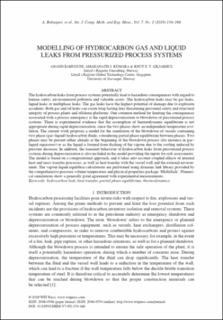| dc.contributor.author | Bahuguni, Anand | |
| dc.contributor.author | Kumara, Amaranath S. | |
| dc.contributor.author | Giljarhus, Knut Erik Teigen | |
| dc.date.accessioned | 2020-06-23T13:38:45Z | |
| dc.date.available | 2020-06-23T13:38:45Z | |
| dc.date.created | 2019-06-11T12:55:40Z | |
| dc.date.issued | 2019 | |
| dc.identifier.citation | Bahuguni, A., Kumara, A.S., Giljarhus, K.E.T (2019) International Journal of Computational Methods & Experimental Measurements, 7(2), pp. 154-166. | en_US |
| dc.identifier.issn | 2046-0546 | |
| dc.identifier.uri | https://hdl.handle.net/11250/2659204 | |
| dc.description.abstract | The hydrocarbon leaks from process systems potentially lead to hazardous consequences with regard to human safety, environmental pollution and valuable assets. The hydrocarbon leaks may be gas leaks, liquid leaks or multiphase leaks. The gas leaks have the highest potential of damage due to explosion accidents. both gas and oil leaks can create long-lasting fires threatening personnel safety and structural integrity of process plants and offshore platforms. One common method for limiting the consequences associated with a process emergency is the rapid depressurization or blowdown of pressurized process systems. There is experimental evidence that the assumption of thermodynamic equilibrium is not appropriate during rapid depressurization, since the two phases show an independent temperature evolution. The current work proposes a model for the simulation of the blowdown of vessels containing two-phase (gas–liquid) hydrocarbon fluids, considering partial phase equilibrium between phases. Two phases may be present either already at the beginning of the blowdown process (for instance in gas–liquid separators) or as the liquid is formed from flashing of the vapour due to the cooling induced by pressure decrease. In addition, the transient behaviour of hydrocarbon leaks from pressurized process systems during depressurization is also included in the model providing the inputs for risk assessments. The model is based on a compositional approach, and it takes into account coupled effects of internal heat and mass transfer processes, as well as heat transfer with the vessel wall and the external environment. The vapour liquid equilibria calculations are performed using dynamic link library provided by the comprehensive pressure volume temperature and physical properties package ‘Multiflash’. Numerical simulations show a generally good agreement with experimental measurements. | en_US |
| dc.language.iso | eng | en_US |
| dc.publisher | WIT Press | en_US |
| dc.subject | hydrokarboner | en_US |
| dc.subject | gasslekkasje | en_US |
| dc.title | Modelling of hydrocarbon gas and liquid leaks from pressurized process systems | en_US |
| dc.type | Peer reviewed | en_US |
| dc.type | Journal article | en_US |
| dc.description.version | publishedVersion | en_US |
| dc.rights.holder | © 2019 WIT Press, www.witpress.com | en_US |
| dc.subject.nsi | VDP::Teknologi: 500 | en_US |
| dc.source.pagenumber | 154-166 | en_US |
| dc.source.volume | 7 | en_US |
| dc.source.journal | International Journal of Computational Methods & Experimental Measurements | en_US |
| dc.source.issue | 2 | en_US |
| dc.identifier.doi | 10.2495/CMEM-V7-N2-154-166 | |
| dc.identifier.cristin | 1703982 | |
| cristin.ispublished | true | |
| cristin.fulltext | postprint | |
| cristin.qualitycode | 1 | |
